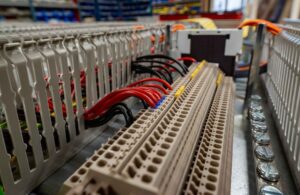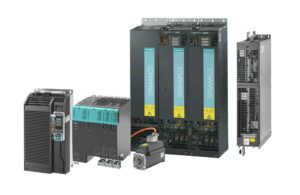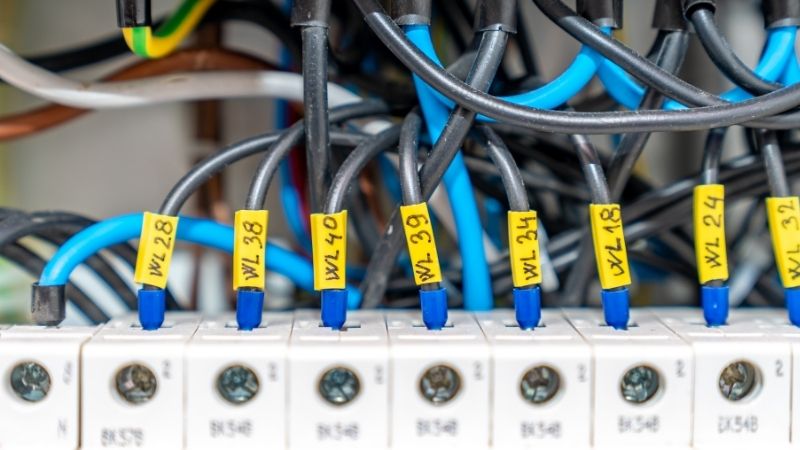Tipi di output PLC: guida essenziale per gli ingegneri dell'automazione
Che tu sia un professionista esperto dell'automazione o che tu stia appena iniziando il tuo percorso, questo articolo ti fornirà spunti preziosi su PLC tecnologie di output.
Sommario
Quali sono i principali tipi di uscite PLC e come funzionano?
Le uscite PLC sono disponibili in diverse varietà, ciascuna progettata per applicazioni e requisiti specifici. I tre tipi principali sono:
- Uscite relè: Dispositivi di commutazione elettromeccanici tradizionali
- Uscite a transistor: Commutazione a stato solido per applicazioni DC
- Uscite Triac: Commutazione a stato solido per applicazioni AC
Le uscite relè sono le più versatili, in quanto possono gestire carichi sia AC che DC. Un tipico modulo di uscita relè contiene bobine fisiche e contatti relè, azionati applicando tensione alla bobina relè. Ad esempio, il Allen Bradley Il modello 1756-OW16I è dotato di 16 uscite relè individuali, il che lo rende adatto a varie applicazioni industriali.
Quali sono le principali differenze tra uscite a stato solido e uscite a relè?
La scelta tra uscite a stato solido e a relè dipende da diversi fattori:
| Caratteristica | Uscite a stato solido | Uscite relè |
|---|---|---|
| Velocità di commutazione | Veloce (microsecondi) | Lento (millisecondi) |
| Durata | Lungo (senza parti mobili) | Limitato (usura meccanica) |
| Gamma di tensione | Limitato a CA o CC | Sia AC che DC |
| Costo | Costo iniziale più elevato | Costo iniziale inferiore |
| Manutenzione | Minimo | Manutenzione regolare richiesta |
Un vantaggio delle uscite relè è la loro indipendenza dalla tensione, che consente loro di commutare carichi sia AC che DC senza richiedere moduli separati. Tuttavia, i dispositivi a stato solido offrono una migliore affidabilità e una maggiore durata di servizio grazie all'assenza di parti mobili.
Come si interfacciano i moduli di uscita digitale con le apparecchiature industriali?
I moduli di output digitali servono come interfaccia tra il programma PLC e i dispositivi esterni. Questi moduli possono controllare:
- Avviatori motore
- Elettrovalvole
- Luci di segnalazione
- Contattori
- Altri dispositivi digitali o discreti
Il modulo di output funziona in base alle decisioni prese dal programma PLC, convertendo queste decisioni in azioni fisiche tramite segnali di tensione o corrente. Ad esempio, è possibile utilizzare un output per azionare un carico CA e un altro output per controllare un carico CC, offrendo opzioni di controllo flessibili.
Quali sono le considerazioni importanti per la selezione dell'uscita PLC?
Quando si selezionano le uscite PLC, considerare questi fattori cruciali:
- Valori nominali di tensione e corrente
- Requisiti di tensione di esercizio
- Assorbimento massimo di corrente
- Esigenze di protezione contro le sovratensioni
- Requisiti di commutazione
- Frequenza di commutazione
- Tipo di carico (resistivo, induttivo, capacitivo)
- Requisiti di tempo di risposta
- Condizioni ambientali
- Temperatura di esercizio
- Livelli di umidità
- Rumore elettrico
Quali sono i problemi più comuni di risoluzione dei problemi con le uscite PLC?
La comprensione dei problemi di output comuni aiuta a mantenere l'affidabilità del sistema:
- Protezione da cortocircuito delle uscite
- Cadute di tensione su lunghe distanze
- Interferenza da apparecchiature vicine
- Sintomi di guasto del modulo di output
- Tecniche di messa a terra adeguate
Domande frequenti
Un modulo di output PLC converte le decisioni del programma in azioni fisiche controllando dispositivi esterni tramite segnali elettrici.
La scelta dipende dai requisiti di carico e dalla progettazione del sistema. Le uscite sinking sono comuni in Nord America, mentre le uscite sourcing sono prevalenti in Europa.
Le uscite a transistor offrono velocità di commutazione più elevate, durata maggiore e nessuna usura meccanica, rendendole ideali per applicazioni ad alta velocità.
Le uscite a relè sono preferite quando è richiesta flessibilità di tensione o quando è richiesto un isolamento elettrico completo tra i circuiti di controllo e di carico.
Utilizzare un'adeguata protezione contro le sovratensioni, assicurare il corretto cablaggio, mantenere i carichi nominali adeguati e implementare misure di raffreddamento adeguate.
Dai potenza ai tuoi progetti con i nuovi PLC originali Omron, Mitsubishi e Schneider, disponibili in magazzino e pronti da subito!
Conclusione
- Le uscite PLC sono di tre tipi principali: relè, transistor e triac
- Ogni tipo di output ha vantaggi e applicazioni specifici
- La selezione corretta dipende dai requisiti di carico e dalle condizioni ambientali
- La manutenzione e il monitoraggio regolari garantiscono un funzionamento affidabile
- Le misure di protezione sono essenziali per l'affidabilità a lungo termine
Cerchi nuovi PLC originali per i tuoi progetti? Da Kwoco, abbiamo in magazzino gli ultimi PLC dei migliori marchi come Omron, Mitsubishi, E SchneiderAcquista con fiducia: spedizione veloce, qualità garantita! Acquista ora
Contattaci
Basta compilare il tuo nome, indirizzo email e una breve descrizione della tua richiesta in questo modulo. Ti contatteremo entro 24 ore.
Categoria di prodotto
Prodotti in saldo
Potresti trovare interessanti anche questi argomenti

24 V CC vs 120 V CA: comprendere le differenze nell'automazione
Quando si selezionano le tensioni di controllo per l'automazione industriale, due scelte comuni sono 24 V CC e 120 V CA. Ma come si fa a decidere quale sia la scelta giusta per la propria applicazione? In questo articolo, analizzeremo le principali differenze tra 24 V CC e 120 V CA, esploreremo i loro utilizzi nei sistemi di automazione e ti aiuteremo a prendere una decisione informata in base alle tue esigenze.

10 informazioni essenziali sulla serie OMRON PLC CJ2
10 informazioni essenziali sulla serie OMRON PLC CJ2 KWOCO si concentra su prodotti di automazione industriale di fama internazionale, ho avuto una vasta esperienza pratica

Errori SINAMICS S120: guida alla risoluzione dei problemi
Questo articolo funge da guida dettagliata per comprendere e risolvere i codici di errore SINAMICS S120. Che tu sia un ingegnere esperto o un novizio nell'automazione industriale, questa risorsa fornisce preziosi approfondimenti sulle complessità degli azionamenti SINAMICS S120, aiutandoti a diagnosticare e risolvere i guasti in modo efficiente. Con un focus sulle soluzioni pratiche, miriamo a fornirti le conoscenze necessarie per ridurre al minimo i tempi di fermo e ottimizzare le prestazioni dei tuoi macchinari.






